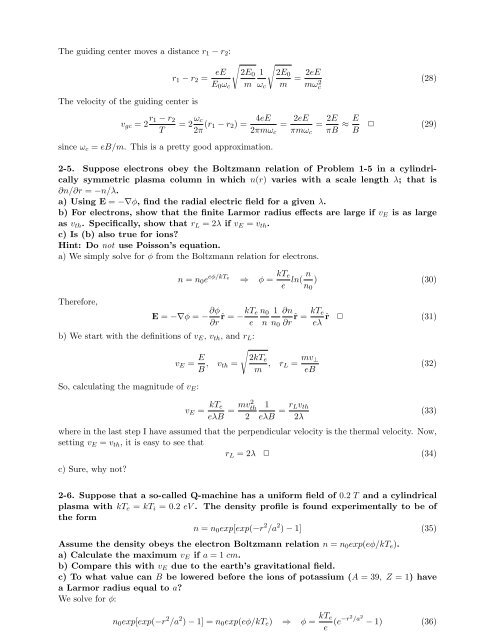Solutions to Chen's Plasma Physics
Solutions to Chen's Plasma Physics
Solutions to Chen's Plasma Physics
You also want an ePaper? Increase the reach of your titles
YUMPU automatically turns print PDFs into web optimized ePapers that Google loves.
The guiding center moves a distance r 1 − r 2 :<br />
r 1 − r 2 =<br />
√ √<br />
eE 2E 0 1 2E 0<br />
E 0 ω c m ω c m<br />
= 2eE<br />
mω 2 c<br />
(28)<br />
The velocity of the guiding center is<br />
v gc = 2 r 1 − r 2<br />
T<br />
= 2 ω c<br />
2π (r 1 − r 2 ) =<br />
4eE<br />
2πmω c<br />
=<br />
since ω c = eB/m. This is a pretty good approximation.<br />
2eE = 2E<br />
πmω c πB ≈ E B ✷ (29)<br />
2-5. Suppose electrons obey the Boltzmann relation of Problem 1-5 in a cylindrically<br />
symmetric plasma column in which n(r) varies with a scale length λ; that is<br />
∂n/∂r = −n/λ.<br />
a) Using E = −∇φ, find the radial electric field for a given λ.<br />
b) For electrons, show that the finite Larmor radius effects are large if v E is as large<br />
as v th . Specifically, show that r L = 2λ if v E = v th .<br />
c) Is (b) also true for ions?<br />
Hint: Do not use Poisson’s equation.<br />
a) We simply solve for φ from the Boltzmann relation for electrons.<br />
Therefore,<br />
n = n 0 e eφ/kTe ⇒ φ = kT e<br />
e ln( n n 0<br />
) (30)<br />
E = −∇φ = − ∂φ<br />
∂r ˆr = −kT e n 0 1 ∂n<br />
e n n 0 ∂r ˆr = kT e ˆr ✷ (31)<br />
eλ<br />
b) We start with the definitions of v E , v th , and r L :<br />
√<br />
v E = E B , v 2kT e<br />
th =<br />
m ,<br />
So, calculating the magnitude of v E :<br />
r L = mv ⊥<br />
eB<br />
v E = kT e<br />
eλB = mv2 th 1<br />
2 eλB = r Lv th<br />
2λ<br />
where in the last step I have assumed that the perpendicular velocity is the thermal velocity. Now,<br />
setting v E = v th , it is easy <strong>to</strong> see that<br />
r L = 2λ ✷ (34)<br />
c) Sure, why not?<br />
(32)<br />
(33)<br />
2-6. Suppose that a so-called Q-machine has a uniform field of 0.2 T and a cylindrical<br />
plasma with kT e = kT i = 0.2 eV . The density profile is found experimentally <strong>to</strong> be of<br />
the form<br />
n = n 0 exp[exp(−r 2 /a 2 ) − 1] (35)<br />
Assume the density obeys the electron Boltzmann relation n = n 0 exp(eφ/kT e ).<br />
a) Calculate the maximum v E if a = 1 cm.<br />
b) Compare this with v E due <strong>to</strong> the earth’s gravitational field.<br />
c) To what value can B be lowered before the ions of potassium (A = 39, Z = 1) have<br />
a Larmor radius equal <strong>to</strong> a?<br />
We solve for φ:<br />
n 0 exp[exp(−r 2 /a 2 ) − 1] = n 0 exp(eφ/kT e ) ⇒ φ = kT e<br />
e (e−r2 /a 2 − 1) (36)

















